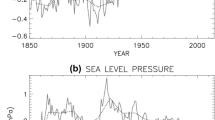Abstract
Spatial patterns of mid-latitude large-scale ocean-atmosphere interaction on monthly to seasonal time scales have been observed to exhibit a similar structure in both the North Pacific and North Atlantic basins. These patterns have been interpreted as a generic oceanic response to surface wind anomalies, whereby the anomalous winds give rise to corresponding anomalous regions of surface heat flux and consequent oceanic cooling. This mechanistic concept is investigated in this study using numerical models of a global atmosphere and a mid-latitude ocean basin (nominally the Atlantic). The models were run in both coupled and uncoupled mode. Model output was used to generate multi-year time series of monthly mean fields. Empirical orthogonal function (EOF) and singular value decomposition (SVD) analyses were then used to obtain the principal patterns of variability in heat flux, air temperature, wind speed, and sea surface temperature (SST), and to determine the relationships among these variables. SVD analysis indicates that the turbulent heat flux from the ocean to the atmosphere is primarily controlled by the surface scalar wind speed, and to a lesser extent by air temperature and SST. The principal patterns of air-sea interaction are closely analogous to those found in observational data. In the atmosphere, the pattern consists of a simultaneous strengthening (or weakening) of the mid-latitude westerlies and the easterly trades. In the ocean there is cooling (warming) under the anomalously strong (weak) westerlies and trade winds, with a weaker warming (cooling) in the region separating the westerly and easterly wind regimes. These patterns occur in both coupled and uncoupled models and the primary influence of the coupling is in localizing the interaction patterns. The oceanic patterns can be explained by the principal patterns of surface heat flux and the attendant warming or cooling of the ocean mixed layer.
Similar content being viewed by others
References
Bjerknes J (1964) Atlantic air-sea interaction. Adv Geophys 20:1–82
Bleck R, Hanson HP, Hu D, Kraus EB (1989) Mixed layer/thermocline interaction in a three-dimensional isopycnal model. J Phys Oceanogr 19:1417–1439
Bretherton CS, Smith C, Wallace JM (1992) An intercomparison of methods for finding coupled patterns in climate data. J Clim 5:541–560
Cayan DR (1992a) Latent and sensible heat flux anomalies over the Northern Oceans: the connection to monthly atmospheric circulations. J Clim 5:354–369
Cayan DR (1992b) Latent and sensible heat flux anomalies over the Northern Oceans: driving the sea surface temperature. J Phys Oceanogr 22:859–881
Frankignoul C (1985) Sea surface temperature anomalies, planetary waves and air-sea feedback in the middle latitudes. Rev Geophys 23:357–390
Kraus EB, Turner JS (1967) A one-dimensional model of the seasonal thermocline: II. The general theory and its consequences. Tellus 19:98–106
Hellerman S, Rosenstein M (1983) Normal monthly wind stress over the world ocean with error estimates. J Phys Oceanogr 13:1093–1104
Lanzante JR (1984) A rotated eigenanalysis of the correlation between 700 mb heights and sea surface temperatures in the Pacific and Atlantic. Mon Weather Rev 112:2270–2280
Manabe S, Stouffer RJ (1988) Two stable equilibria of a coupled ocean-atmosphere model. J Clim 1:841–866
Manabe S, Stouffer RJ, Spelman MJ, Bryan K (1991) Transient responses of a coupled ocean-atmosphere model to gradual changes of atmospheric CO2. Part I: annual mean response. J Clim 4:785–818
Miller AJ, Roads JO (1990) A simplified coupled model of extended-range predictability. J Clim 3:523–542
Namias J, Cayan DR (1981) Large-scale air-sea interactions and short-period climatic fluctuations. Science 214:869–876
Namias J, Yuan X, Cayan DR (1988) Persistence of North Pacific sea surface temperature and atmospheric flow patterns. J Clim 1:682–703
Peixoto JP, Oort AH (1992) Physics of Climate. American Institute of Physics 520 pp
O'Brien E, Stewart DA, Branscome LE (1994) Tropical-extratropical interactions on intraseasonal time scales in a global spectral model. J Atmos Sci 51:1244–1260
Palmer TN, Sun ZB (1985) A modeling and observational study of the relationship between sea surface temperature in the northwest Atlantic and the atmospheric general circulation. Q J R Meteorol Soc 111:947–975
Sausen R, Barthel K, Hasselmann K (1988) Coupled atmosphere models with flux correction. Clim Dyn 2:145–163
Wallace JM, Gutzler DS (1981) Teleconnections in the geopotential height field during the northern hemisphere winter. Mon Wea Rev 109:784–812.
Wallace JM, Smith C, Jiang Q (1990) Spatial patterns of Atmosphere-Ocean interaction in the Northern Winter. J Clim 3:990–998
Wallace JM, Smith C, Bretherton CS (1992) Singular value decomposition of wintertime sea surface temperature and 500 mb height anomalies. J Clim 5:561–576
Author information
Authors and Affiliations
Rights and permissions
About this article
Cite this article
O'Brien, E.W., Chassignet, E.P. Extratropical large-scale air-sea interaction in a coupled and uncoupled ocean-atmosphere model. Climate Dynamics 12, 53–65 (1995). https://doi.org/10.1007/BF00208762
Received:
Accepted:
Issue Date:
DOI: https://doi.org/10.1007/BF00208762




